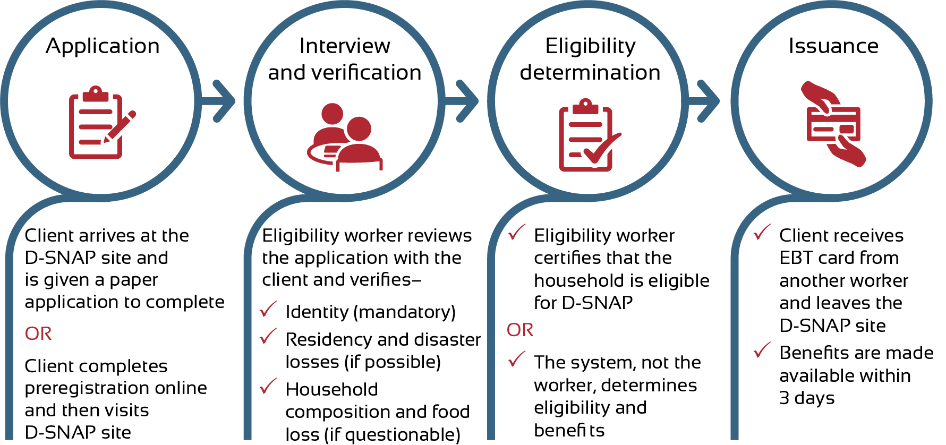H. Final D-SNAP Site Observational Tool
H. Final D-SNAP Site Observational Tool.docx
Best Practices in Disaster Supplemental Nutrition Assistance Program (D-SNAP) Operations and Planning
H. Final D-SNAP Site Observational Tool.docx
OMB: 0584-0668
Attachment
H. Final D-SNAP Site
Observational Tool
OMB No. 0584-[NEW]
Best Practices in Disaster Supplemental Nutrition Assistance Program (D-SNAP) Operations and Planning
Project Officer: Eric Sean Williams
Office of Policy Support
SNAP Research and Analysis Division
Food and Nutrition Service
U.S. Department of Agriculture
1320 Braddock Place
Alexandria, VA 22314
703.305.2640
OMB
Number: 0584-XXXX Expiration
Date: XX/XX/XXXX
Purpose of this Document: This observational tool is intended to serve as a guide to study team observers who will be conducting in-person site visits to observe the locations where disasters and D-SNAPs took place. Site visits will be not be conducted during a disaster. The observation is designed to be conducted as key staff involved in D-SNAP implementation provide a walk-through tour of the D-SNAP site (OMB Control No: 0584-0083, expiration date 08/31/2023) and the local area previously affected by the disaster. As such, the observational exercise will include an interview/discussion component during the tour. Study team observers will use this document to take notes throughout the exercise.
Instructions to Study Team: This tool has three parts: a cover sheet to be populated with general information on the D-SNAP, a section for documenting observations about the local area that was affected by the disaster, and a section for documenting observations at the D-SNAP site itself. Using this tool as a guide, observers will gather key information ahead of the observation, observe the area previously affected by the disaster and the D-SNAP site itself, and ask clarifying questions of D-SNAP implementers participating in the observation during the tour. Observers will give special attention to accessibility, Americans with Disabilities Act of 1990 (ADA) compliance, provisions for safety and human needs, security, and protections for program integrity during the walk through of the D-SNAP site. Depending on how the site visit is organized, the observer may begin by observing either the D-SNAP site or the disaster area first.
Observers should prepare for the observation by reviewing all documentation in advance, including the D-SNAP request, D-SNAP post-disaster report, D-SNAP State plan, and any materials provided by the D-SNAP site. These materials may include blueprints or other diagrams of the D-SNAP site, maps of the area affected by the disaster, promotional materials, signage used at the site, road closure information, or other materials. This review will help observers confirm, clarify, or probe for additional details during the observation as needed. If these materials have not yet been provided, observers should request them during or following the observation.
If possible, observers should also create a Google MyMap of the D-SNAP site(s) and bring it along during the observation. The map will help the State and local staff answer questions about the affected area, traffic closures, parking, and other issues by identifying them on a map to improve recall.
According
to the Paperwork Reduction Act of 1995, an agency may not conduct or
sponsor, and a person is not required to respond to, a collection of
information unless it displays a valid OMB control number. The valid
OMB control number for this information collection is 0584-xxxx. The
time required to complete this information collection is estimated
to average 4 hours per response, including the time for reviewing
instructions, searching existing data sources, gathering and
maintaining the data needed, and completing and reviewing the
collection of information. Send comments regarding this burden
estimate or any other aspect of this collection of information,
including suggestions for reducing this burden, to the following
address: U.S. Department of Agriculture, Food and Nutrition
Services, Office of Policy Support, 1320 Braddock Place, Alexandria,
VA 22314, ATTN: PRA (0584-xxxx). Do not return the completed form to
this address.
General D-SNAP Information
This information should be filled out before the observations of the disaster area and the D-SNAP site.
Which D-SNAP waiver options were chosen? (Check all that apply)
Food
loss only was considered a qualifying disaster expense
People
who worked but did not live in the area may apply
Automatic
supplements were provided to ongoing SNAP households Disaster
Standard Expense Deduction (DSED) was used
State: ______________________________
Disaster type: ______________________________
Approval date: ______________________________
Application period: ______________________________
Benefit period: ______________________________
Number of applicants: ______________________________
Number of recipients: ______________________________
Application Site Information
What
type of site was used?
Local
SNAP office
Another
State agency building
Local
government agency building
Community-based
organization
School Other
______________________
Address: ________________________________
Point of contact: ________________________________
Observation Information
Date of observation: ___________________________
State/local agency staff: ___________________________
Insight staff: ___________________________
FNS Staff: ___________________________
What resources were available to review before the site observation? (Observer should bring any items that are useful to the observation.)
___ State D-SNAP plans ___ D-SNAP waiver requests ___ D-SNAP reports
___ Maps of disaster area ___ Site blueprints or building plans
___ Announcements and promotional materials ___ D-SNAP site signage
___ Staff training manuals and handbooks on D-SNAP operations and processes at site
___ Photographs ___ Media reports ___ D-SNAP process maps
Additional Information
_____________________________________________________________________________________
_____________________________________________________________________________________
_____________________________________________________________________________________
_____________________________________________________________________________________
_____________________________________________________________________________________
_____________________________________________________________________________________
_____________________________________________________________________________________
_____________________________________________________________________________________
_____________________________________________________________________________________
_____________________________________________________________________________________
_____________________________________________________________________________________
_____________________________________________________________________________________
_____________________________________________________________________________________
_____________________________________________________________________________________
_____________________________________________________________________________________
_____________________________________________________________________________________
_____________________________________________________________________________________
_____________________________________________________________________________________
D-SNAP Site and Disaster Area Observation Tool
[Reintroduce site visitors and the study if needed.] My name is [name], and I’m a researcher at Insight Policy Research. Insight is conducting a study for the U.S. Department of Agriculture’s Food and Nutrition Service (FNS) to identify and document D-SNAP best practices from across the country. This study will equip FNS and States with data demonstrating how to best plan for and implement D-SNAP programs across different disaster types, administrative contexts, and geographic settings. My colleagues and I are currently visiting [STATE] and four other States to collect information from a wide range of stakeholders involved in planning and implementing a D-SNAP program.
[If already introduced to staff participating in observations, start here.] I want to start by thanking you for taking the time to speak with us today and give us a tour of the D-SNAP site and the area affected by the disaster. We have reviewed your State’s D-SNAP plan and documentation from the disaster and talked with staff involved in D-SNAP planning and implementation. Today, we would like to see where the D-SNAP actually took place and understand how it was implemented on the ground. These observations and your perspectives and insights will help us better understand how D-SNAP policy and planning work on the ground.
Your participation in this observation exercise is voluntary, and your responses will be kept private, except as otherwise required by law. Be assured that there will be no penalties if you decide not to respond. The information you provide us today will be summarized and combined with information gathered from other people we talk to into a report that will be shared with FNS and the public. You will not be named in this report or any other project deliverables; however, the specific disasters and States we are studying will be identified. Data collected from the study will also be shared with USDA research and administrative staff, but your name will not be included in the information shared. You may refuse to answer any question, and you may stop the discussion at any time.
Before we continue, can you please read the following Privacy Act Statement?
[Facilitator note: Provide the respondent(s) with a copy of the statement from page 6 of this tool; States have already agreed to participate in this study.]
We will take notes over the course of the observations so that we can remember what you have told us. If it’s okay with you, we may also take some photos of the D-SNAP site or area affected by the disaster to aid in our analysis and report writing. We will not include any identifiable individuals in our photos and will request the State SNAP office review the photos, if any, included in the report. Would that be okay?
Do you have any questions for me about the project in general or what we will be discussing today?
[Instructions to observer: You may begin with either the disaster area or the D-SNAP site observation. Not all questions will apply to all disaster areas, D-SNAPs, or sites. Observers should ask follow-up questions and take photographs (if permitted). Make any additional notes or sketches that will help document the observation and inform analysis, findings, and reporting. Wherever possible, ask to see the surroundings, built environment, or space that is the subject of the question.]
Privacy Act Statement
This information is being collected under the authority of The Food and Nutrition Act of 2008, as amended through Pub. L. 113–128, enacted July 22, 2014 [7 U.S.C. 2026], which provides the legislative authority for the U.S. Department of Agriculture’s (USDA) Food and Nutrition Service (FNS) to administer the Supplemental Nutrition Assistance Program (SNAP) and Disaster SNAP (D-SNAP). Section 17 of the Food and Nutrition Act of 2008 provides the authority to FNS to conduct research to help improve the administration and effectiveness of SNAP. Disclosure of the information is voluntary. The information collected from States and interview participants will enable FNS to identify best practices in administering D-SNAP. Under the Privacy Act of 1974 and the System of Record Notice FNS-8 USDA/FNS Studies and Reports, any personally identifiable information collected will be kept confidential to the extent of the law. The information may be shared with SNAP contract researchers and USDA SNAP research and administrative staff with identifying information removed.
Area Affected by the Disaster
1. Affected Area |
|
|
|
|
|
|
|
Reminder to observer: These are often the same counties served by the D-SNAP but not always. Some D-SNAPs may serve some but not all counties. |
|
|
|
|
|
2. Infrastructure and Access to Food and Services |
|
|
|
|
|
|
|
|
|
3. Observable Ongoing Impacts |
|
|
|
4. Context for Site Selection Note to observer: If possible, before the site visit, create a Google MyMap of the D-SNAP site(s) to help the State and local staff answer the questions below on a map for improved recall. |
|
|
|
|
|
Note to observer: If needed, use the Google MyMap or another map of the vicinity to aid the respondent in answering this question. |
|
|
|
|
|
D-SNAP Site
|
|
Reminder to observer: If copies of signs or photographs of signage are not already in hand, consider asking for them at this time.
|
|
|
|
|
|
|
|
|
|
1. Exterior Signage, Arrival, and Entry (continued) |
|
|
|
|
|
|
|
|
|
2. Physical Space |
|
|
|
Instructions to observer: Describe the physical space that was used. If site diagrams are not available, use this space to take detailed notes and/or draw a diagram of the site and indicate the location of entrances, waiting areas, bathrooms, flow through the process, etc. Identify each part of the D-SNAP application process (at a minimum, each item provided in the figure below). Use additional pages as needed.
|
|
|
|
2. Physical Space (continued) |
|
|
|
|
|
Air conditioning/heat Yes No Available seating Yes No Drinking water Yes No Snacks Yes No |
|
|
|
3. Staffing |
|||||
What types of staff were on site? We will walk through some common staff roles; please tell us if they were part of the process. Note to observer: Ask if each type of staff was on site. The State may have a different term for this role, which should be noted. Some staff may have played more than one role. Include any notes to help clarify the role or function on site. |
|||||
Staff role |
Yes |
No |
Number |
We called them… |
Notes |
Site manager(s) |
|
|
|
|
|
Assistant site manager(s) |
|
|
|
|
|
Supervisors |
|
|
|
|
|
Eligibility workers |
|
|
|
|
Did you have bilingual eligibility workers? What influenced your decision to have bilingual eligibility workers? How many were bilingual? Which languages did they speak?
|
Anti-fraud staff |
|
|
|
|
|
EBT issuance workers |
|
|
|
|
|
Application screeners |
|
|
|
|
|
3. Staffing (continued) |
|||||
What types of staff were on site? We will walk through some common staff roles; please tell us if they were part of the process. Note to observer: Ask if each type of staff was on site. The State may have a different term for this role, which should be noted. Some staff may have played more than one role. Include any notes to help clarify the role or function on site. |
|||||
Staff role |
Yes |
No |
Number |
We called them… |
Notes |
Troubleshooters (to identify issues, help answer questions, etc.) |
|
|
|
|
Whom did they help and how? (Probe if these were State SNAP employees, State staff from other agencies, volunteers from CBOs, etc.)
|
Onsite reviewers |
|
|
|
|
|
Onsite data entry |
|
|
|
|
|
Onsite staff to answer phone calls |
|
|
|
|
|
Security |
|
|
|
|
|
Staff to manage lines, hand out applications, and triage |
|
|
|
|
|
Volunteers |
|
|
|
|
What sorts of tasks did they handle? |
For example, private break rooms, separate bathroom facilities, temporary housing (for out-of-town staff), antibacterial lotion/wipes, onsite first aid, water, or meals? |
|
||||
4. Eligibility |
|
Reminder to observer: Be sure to walk through and observe where and how each part of the process took place on site.
|
|
|
|
|
|
|
|
Please indicate all that apply: Triage the line Hand out applications Answer questions Identify language needs (e.g., translation, nonverbal) Identify people with special needs (disabled, elderly, etc.) Help complete an application if an applicant cannot read or write Advise applicants of the process and estimated wait times |
|
4. Eligibility (continued) |
|
Reminder to observer: Consider these locations relative to individuals who may require assistance. Ask clarifying questions if necessary. (For example, did applicants have to wait until they got through the line and inside the building to get an application, or were staff handing out applications to people who were waiting in line? Did applicants wait until they were with an eligibility worker before anyone learned they couldn’t speak English?)
|
|
Note to observer: Note whether and how these areas were set up to protect applicants’ privacy. Probe for additional information as needed.
|
|
|
|
|
|
Reminder to observer: Volunteers cannot check for duplicate participation. |
|
|
|
5. Issuance |
|
|
|
|
|
|
|
Please indicate all that apply: How to use an EBT card Eligible SNAP purchase items How D-SNAP is different from regular SNAP Availability of regular SNAP after the disaster Fraud |
|
|
|
|
|
6. Wrap Up |
|
|
|
|
|
|
|
|
|
Thank you for your time and participation in this study!
Additional Notes
____________________________________________________________________________________________________________
____________________________________________________________________________________________________________
____________________________________________________________________________________________________________
____________________________________________________________________________________________________________
____________________________________________________________________________________________________________
____________________________________________________________________________________________________________
____________________________________________________________________________________________________________
____________________________________________________________________________________________________________
| File Type | application/vnd.openxmlformats-officedocument.wordprocessingml.document |
| Author | Allyson Corbo |
| File Modified | 0000-00-00 |
| File Created | 2021-07-07 |
© 2025 OMB.report | Privacy Policy
